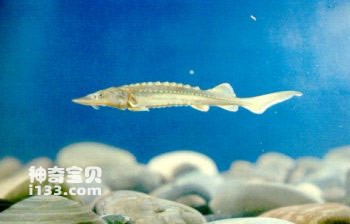Acipenser dabryanus belongs to the order Acipenser, family Acipenser, and genus Acipenser. Commonly known as: Sha Lazi, Xiao Lazi, sturgeon, and catfish. English name: River sturgeon, Dabry’s sturgeon.
Endangerment level: Vulnerable. China's national first-level protected wild animals.
IUCN (1996) CR CITES (1997) Appendix II.

The body length is fusiform. The head is wedge-shaped and rough on the back. The snout is short and tapered at the front. The mouth is inferior, with transverse cleft, and the lips have small papillae. There are 2 pairs of whiskers on the snout and abdomen. Eyes are small (relatively larger than Chinese sturgeon). The nostrils and gills are both large. The opercular membrane is connected to the gill isthmus. The left and right gill openings are separated. The body is covered with 5 rows of bony plate-like hard scales, and the epidermis between the scales is rough. Tail crooked. The appearance is similar to the Chinese sturgeon, but the adult fish is shorter and lighter in weight. Gill rakers are triangular and thin, with 33-54 pieces. The back and sides of the body are bluish gray. The ventral surface is grayish white. Fins blue-grey with white edges.
The Dachshund's sturgeon is a freshwater resident fish. Often active in the middle and lower layers of rivers, it is more common from above Shashi in Hubei Province to the lower reaches of Jinsha River in the Yangtze River, and also enters large lakes. It especially likes to inhabit river bays or deep rivers with slow flow, rich in humus and benthic organisms, sandy bottom or pebble dams. Growth rate is faster. In the reproductive group, males reach sexual maturity at 4-7 years old and females at 5-8 years old. The general body length is 0.8-1.0 meters and the weight is 5-10 kilograms. The spawning season is from October to November, with a few extending to December. Sexually mature individuals go upstream and to the main river channels during the breeding season to lay eggs. The eggs are sinking and sticky. The eggs stick to the gravel bottom of the spawning ground and develop. The feeding habits are mainly benthic invertebrates, but also aquatic plants, algae and humus. Young fish feed on aquatic oligochaeta, dragonfly larvae, dipteran larvae, chironomid larvae and small fish; larger juvenile fish and adults feed on humus and benthic invertebrates. Feeding is generally stopped during the spawning period.
Distributed in the main tributaries of the Yangtze River and large lakes along the Yangtze River in China. It is a large economic fish produced in the upper reaches of the Yangtze River. Its natural output is not large, but it still occupies a certain position in the fishery of the production area. In the past two decades, the number has greatly decreased and it is in an endangered state. At present, it has received the attention of the provinces in the upper reaches of the Yangtze River and is effectively protected like the Chinese sturgeon.
animal tags:
We created this article in conjunction with AI technology, then made sure it was fact-checked and edited by a Animals Top editor.